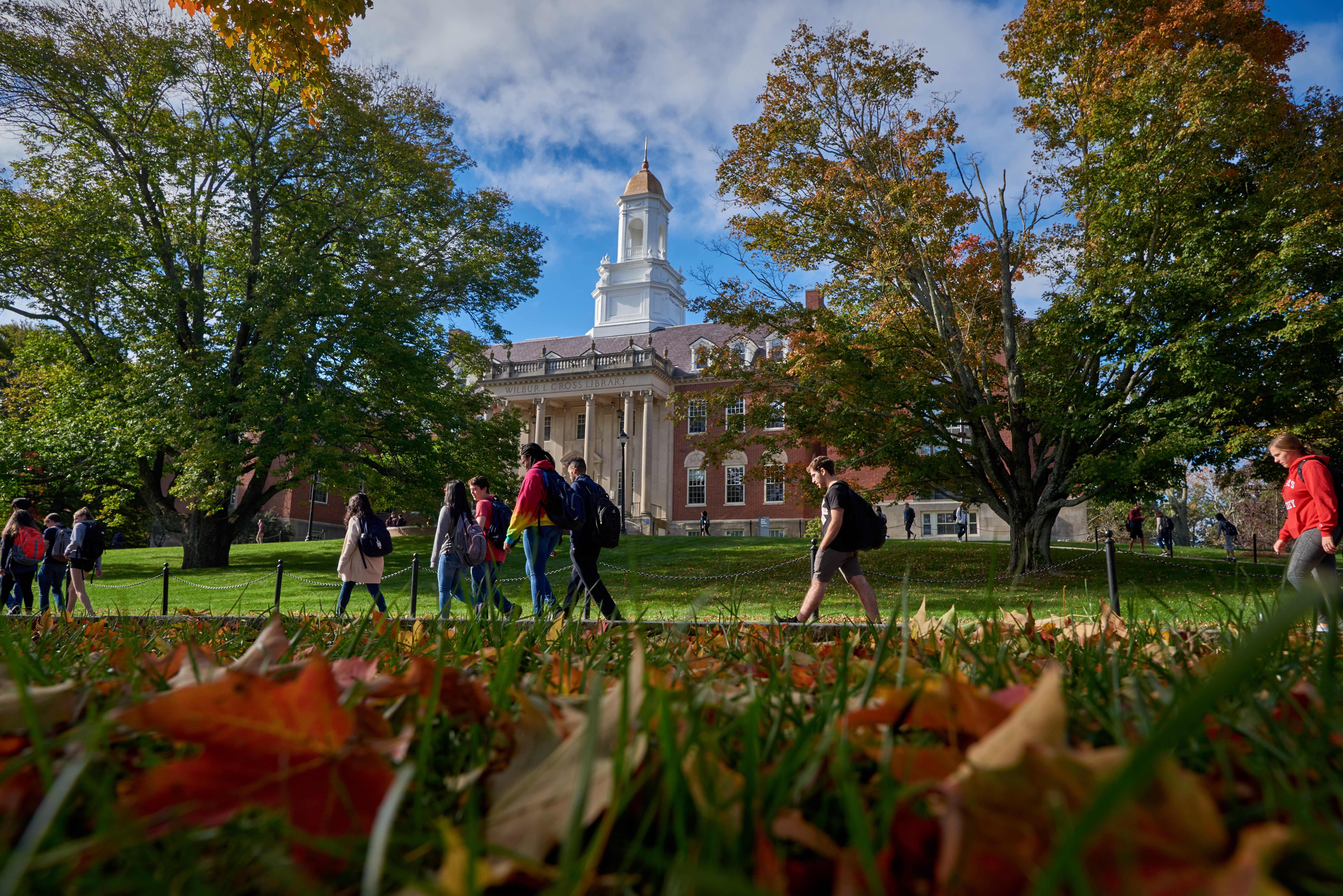'Hundreds of people have participated to make sure we're ready to teach and advise in the new curriculum'

(Peter Morenus/UConn Photo)
An intensive six-year process to update UConn's core academic enterprise comes to fruition at the start of the 2025-26 academic year this month with the launch of the university's new Common Curriculum.
Replacing the previous General Education program, the Common Curriculum is designed to provide UConn undergraduates with the foundation of critical knowledge and skills necessary for them to engage as leaders and global citizens.
The Common Curriculum goes into effect for newly enrolled students with the start of the new 2025-26 semester and represents UConn's first overhaul of its foundational academic requirements since fall 2005.
Returning students will continue to build their schedules and satisfy credit requirements under the previous General Education model, although they can switch to the new Common Curriculum model if they wish.
UConn's previous General Education curriculum centered largely on discipline-specific areas along with some broad topics, such as environmental literacy.
The new Common Curriculum breaks down the perceived lines between academic disciplines, focusing instead on six Topics of Inquiry (TOI) designed to help explore inter- and cross-disciplinary courses.
In this way, students connect topics that previously might have seemed disparate, while also cultivating their creativity and innovation through interdisciplinary learning. The Common Curriculum also promotes flexibility for students to reach their academic goals through paths best suited to their interests and needs.
A curriculum that's more interdisciplinary than ever
Critically, the Common Curriculum aims to ensure that students can demonstrate versatility and adaptability in a rapidly changing world; integrate knowledge in innovative or creative ways; and apply learning strategies to new contexts.
It also complements the goals of UConn's Strategic Plan, including its commitment to holistic student success that positions students for academic, career, and life success after graduation.
"At many universities, general education is localized within certain departments or disciplines. The great thing about UConn's Common Curriculum is that 'general education' can happen in any department, school, or college," says Karen McDermott, the Common Curriculum Committee's program assistant, who coordinated the transition of UConn's nearly 500 general education courses into the new model and processed proposals for new courses.

"As someone who works with faculty and courses from across the university, I can easily see the connections and overlaps between areas, and one of Common Curriculum's aims is to maximize those connections and overlaps for students," McDermott says. "The modern university curriculum is more interdisciplinary than ever, and UConn's program really highlights this."
Here's how the Common Curriculum's requirements work:
Undergraduates must earn at least 120 credits to receive a bachelor's degree, including at least 40 credits in Common Curriculum and competency areas. To satisfy their requirements, students will complete at least three credits within each of the Topics of Inquiry below:
• Creativity: Design, Expression, Innovation
• Cultural Dimensions of Human Experiences
• Diversity, Equity, and Social Justice
• Individual Values and Social Institutions
• Scientific and Empirical Inquiry
Students will take at least 21 credits of TOIs covering six different subject areas, including nine credits that either focus on one TOI or that are in a Theme. Three of these credits must also be in a course designated as a TOI-6L laboratory science course.
Students must also satisfy competency requirements with two writing-intensive (W) courses; two quantitative (Q) courses, one that includes mathematics and statistics; and two second language competency courses, although some students satisfy this requirement through their high school courses.
In a new addition, students also must exhibit competency in the collaborative and relational aspects of dialogue among different people and points of view, as well as in information, digital, and media literacy (IDML).
Those skill sets will be infused throughout the curriculum and embedded in the TOIs to help students collaborate on addressing challenges locally and globally; recognize human differences and how they can enhance our lives; express quantitative and qualitative ideas in written, visual, aural, and/or oral forms; and interpret, solve, and/or model problems.
Almost three-quarters of the courses in the Common Curriculum have two TOI designations, adding to students' flexibility and opportunities to stitch together special interest areas across the curriculum.
The TOI model moves away from old perceptions, such as the idea that creativity exists primarily in the arts and humanities. Rather, the Common Curriculum creates new opportunities by recognizing that creativity is present and can be further cultivated in areas such as business, the sciences, and beyond.
Connecting academic learning and real-world application
First-year UConn students and those readmitted for the new 2025-26 fall semester will follow the requirements of the new Common Curriculum, which applies to undergraduates across all UConn campuses.
Continuing students, incoming transfer students, and students who have taken an approved leave of absence and return within three semesters can determine whether they want to follow the previous General Education requirements or the new Common Curriculum requirements.
The university's schools and colleges will work directly with students to help them understand the Common Curriculum, including how to identify and select cross-disciplinary courses that best meet their interests and credit requirements.
The Common Curriculum also complements the eight career competencies identified by the National Association of Colleges and Employers (NACE), which help bridge the gap between academic learning and real-world application, improving students' employability and career success.

"One of the things that's most exciting about the career piece is our new partnership with the Center for Career Readiness and Life Skills. This office has been fantastic in helping us make the implicit explicit by working with their Faculty Fellows to directly embed the career competencies into the curriculum," says Jamie Kleinman, a UConn associate professor in residence in psychological sciences and the Common Curriculum Faculty Assessment Fellow.
UConn is not alone in its review and overhaul of its general education requirements. Colleges and universities nationwide increasingly are taking a new look at their offerings and realigning the curriculum to ensure the courses are relevant, engaging, and that they encourage students to delve deeper into topics they might not otherwise have explored.
A lot of work, and a lot of excitement
UConn's change from the General Education model to the Common Curriculum involved six years of work and participation from almost 80 departments throughout the University, led by a committee of faculty and staff from various disciplines and campuses.
It also required broad collaboration across the University and with critical external partners, including the Connecticut Community College. UConn officials also have been working with high schools to ensure that guidance counselors and teachers of Early College Experience (ECE) courses have clarity on the new approach and know who to contact with questions.
The teams of faculty and staff working on developing the Common Curriculum held to a busy schedule of duties that did not slow even during the COVID pandemic, including examining hundreds of existing courses to determine where they fit under the Topics of Inquiry (TOI) model and developing or revising others.
By the end of spring 2025, the University had transitioned more than 450 courses into the Common Curriculum, created 65 new grant-funded courses, and revised 60 more.
The work also involved anticipating and addressing how faculty and staff advisors would best be able to help students who now span two different sets of requirements, depending on when they entered the university.
The plan is crafted to accommodate the procedures under which UConn reviews and accepts transfer credits from other institutions, including from student athletes being considered for UConn Athletics teams; high school students looking to bring in Early College Experience (ECE) credit; and other special circumstances.
"There's a lot of excitement around the new Common Curriculum among faculty and advisors," says Pamela Bedore, a UConn associate professor in English and chairperson of the Common Curriculum Committee.
"It's been a lot of work to make a change this big, but hundreds of people have participated to make sure we're ready to teach and advise in the new curriculum," she says. "I can't wait to teach my own brand-new Common Curriculum course in the fall and to see how students respond to the new material."






